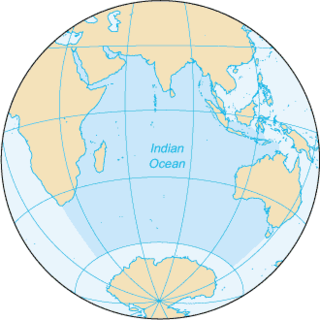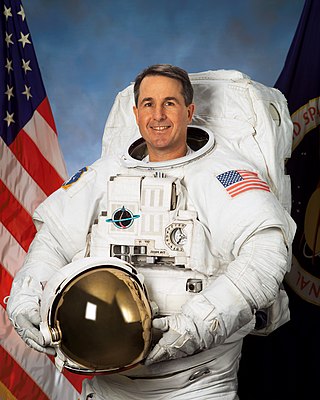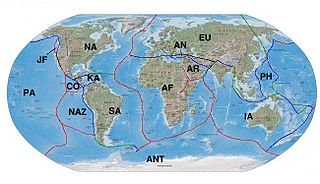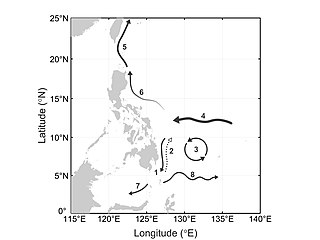
The Indian Ocean is the third-largest of the world's five oceanic divisions, covering 70,560,000 km2 (27,240,000 sq mi) or approximately 20% of the water area of Earth's surface. It is bounded by Asia to the north, Africa to the west and Australia to the east. To the south it is bounded by the Southern Ocean, or Antarctica, depending on the definition in use. The Indian Ocean has large marginal, or regional seas, such as the Andaman Sea, the Arabian Sea, the Bay of Bengal, and the Laccadive Sea.

The Lombok Strait is a strait of the Bali Sea connecting to the Indian Ocean, and is located between the islands of Bali and Lombok in Indonesia. The Gili Islands are on the Lombok side.

Stephen Kern "Steve" Robinson is an American former NASA astronaut.

The Indo-Australian plate is or was a major tectonic plate. It is in the process of separation into three plates, and may be currently separated into more than one plate. It contains the continent of Australia, its surrounding ocean and extends north-west to include the Indian subcontinent and the adjacent waters.

The Indonesian Throughflow is an ocean current with importance for global climate as is the low-latitude movement of warm, relative freshwater from the north Pacific to the Indian Ocean. It thus serves as a main upper branch of the global heat/salt conveyor belt.

Ombai Strait is an international strait in Southeast Asia. It separates the Alor Archipelago from the islands of Wetar, Atauro, and Timor in the Lesser Sunda Islands. The strait is also the western portion of a pair of international straits, the other one being Wetar Strait; the two straits combine to link the Pacific Ocean with the Indian Ocean.

Wetar Strait is an international strait in Southeast Asia. It separates the island of Wetar from the eastern part of the island of Timor. The strait is also the eastern portion of a pair of international straits, the other one being Ombai Strait; the two straits combine to link the Indian Ocean with the Pacific Ocean.
The Tasman Outflow is a water pathway connecting water from the Pacific Ocean and the Indian Ocean. The existence of the outflow was published by scientists of the Australian CSIRO's Division of Marine and Atmospheric Research team in August 2007, interpreting salinity and temperature data captured from 1950 to 2002. The Tasman Outflow is seen as the missing link in the supergyre of the Southern Hemisphere and an important part of the thermohaline circulation.

The Mindanao Current (MC) is a southward current in the western Pacific Ocean that transports mass and freshwater between ocean basins. It is a low-latitude western boundary current that follows the eastern coast of the Philippine island group and its namesake, Mindanao. The MC forms from the North Equatorial Current (NEC) that flows from east to west between 10-20°N. As it travels west, the NEC reaches its western limit: the coast of the Philippines. Once it encounters shallower waters near land, it “splits” into two branches: one moves northward and becomes the Kuroshio current and one moves southward and becomes the Mindanao Current. The process of splitting is called a bifurcation.

Amed is a village on the east coast in Abang District, Karangasem Regency, Bali, Indonesia. In the wake of heavy tourism development, actors in the tourism industry use the village's name to designate a 14-km stretch of coast that includes several other villages, namely from west to east: Amed, Jemeluk, Bunutan, Lipah, Lehan, Selang, Banyuning, Aas and Kusambi. A more correct geographical name would be the north coast of the Seraya peninsula, or North Seraya.

Leanne Armand was an Australian professor of marine science. She was an expert in the identification of diatoms in the Southern Ocean. She was known for her contributions to the understanding of past Southern Ocean dynamics and sea ice as a result of her knowledge of diatom distributions and ecology.
Susan Elizabeth Anne Wijffels is an Australian oceanographer employed by the Woods Hole Oceanographic Institution (WHOI); she formerly worked from the Commonwealth Scientific and Industrial Research Organisation (CSIRO) in Australia. Wijffels specialises in quantifying global ocean change over the past 50 years, including its anatomy and drivers. She is recognised for her international and national leadership of the Global Ocean Observing System. She is regarded as an expert in the Indonesian Throughflow and its role in global climate.

The Ashmore Reef Marine Park is an Australian marine park that covers the Ashmore Reef, which is located about 630 km (390 mi) north of Broome and 110 km (68 mi) south of the Indonesian island of Rote. The marine park covers an area of 583 km2 (225 sq mi) and is assigned IUCN category Ia. It is one of 13 parks managed under the North-west Marine Parks Network.

Peter George Baines is an Australian geophysicist. He is an honorary senior fellow at University of Melbourne and a Fellow of the Royal Society of Victoria.

William Ka Ming Lau is a senior scientist at the Earth System Science Interdisciplinary Center, a research center at the University of Maryland and an adjunct professor of the Department of Atmospheric and Oceanic Sciences at the University of Maryland. A physicist by training, his research spans over 4 decades covering a wide range of topics in climate dynamics, tropical meteorology, ocean-atmosphere coupling, aerosol-water cycle interactions, and climate variability and change. Lau conducted pioneering research on atmospheric teleconnection, and the global monsoon climate system. He discovered the aerosol-monsoon regional feedback mechanism, i.e., the Elevated Heat Pump (EHP) effect that strongly modulate climate change in Asian monsoon regions. He was the senior author of a popular research reference book, “Intraseasonal Variability in the Atmosphere-Ocean Climate System”. As of November 2020, he has coauthored 297 refereed papers, with total citation = 33,932, h-index=101.
Janet Margaret Hergt is an Australian geochemist. She is a Redmond Barry Distinguished Professor in the School of Geography, Earth and Atmospheric Sciences at the University of Melbourne, Victoria, Australia. The main focus of her research has been in the chemical analysis of rocks and minerals to explore the exquisite record of Earth processes preserved within them. Hergt is best known for her geochemical investigations of magmatic rocks although she has employed similar techniques in interdisciplinary projects including areas of archaeological and biological science.
Low-latitude western boundary currents (LLWBC) are western boundary currents located between the subtropical gyres, within 20° of the equator. They are important for closing the tropical circulation driven by the equatorial zonal flow, and facilitate inter-ocean transport between the subtropical gyres. They occur in regions of negative (positive) wind stress curl in the southern (northern) hemisphere, and originate at the western bifurcation point of the South or North Equatorial Current. They are typically equatorward (cyclonic) as opposed to sub-tropical western boundary currents, which tend to be poleward (anticyclonic). Some well-known examples include the Mindanao Current (MC) and the East African Coastal Current (EACC).
Ocean dynamical thermostat is a physical mechanism through which changes in the mean radiative forcing influence the gradients of sea surface temperatures in the Pacific Ocean and the strength of the Walker circulation. Increased radiative forcing (warming) is more effective in the western Pacific than in the eastern where the upwelling of cold water masses damps the temperature change. This increases the east-west temperature gradient and strengthens the Walker circulation. Decreased radiative forcing (cooling) has the opposite effect.
Paola Malanotte Rizzoli is an Italian physical oceanographer known for her research on ocean circulation and sea level rise, especially with respect to flooding conditions in Venice.
Mary-Louise Elizabeth Timmermans is a marine scientist known for her work on the Arctic Ocean. She is the Damon Wells Professor of Earth and Planetary Sciences at Yale University.













